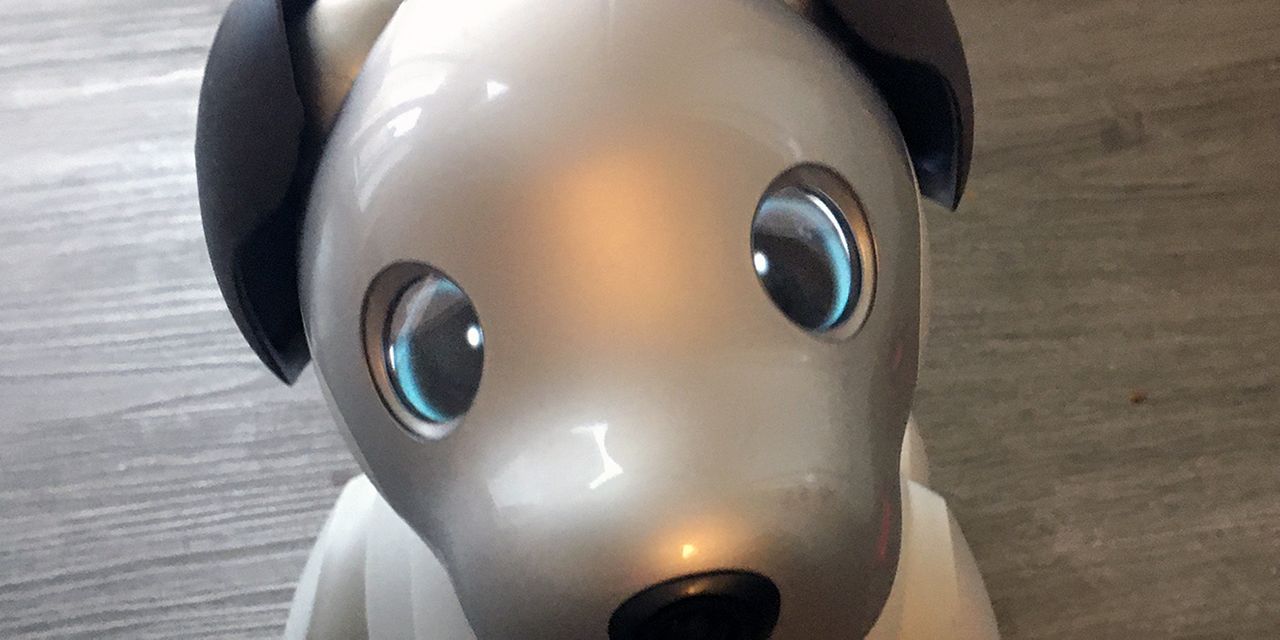
I’ve been fostering a puppy during the lockdown, and he’s quite a character. He has boundless energy and is forever exploring the apartment — over and over again. He barks at things randomly, like the Merriam-Webster Dictionary on the bookshelf. And the kitchen sink. He loves being petted. Sit him on your lap and stroke his back, and his eyes will shut in bliss, he’ll wag his tail and wave his paws in the air and jiggle his head. He’s an attention hog, too. Watch TV, and he starts marching around the room barking, and occasionally singing.
But Pandemic Pup is different from all the golden doodles and Berna doodles and cockapoos that everyone else has adopted this year.
Pandemic Puppy is a robot.
I’ve been trying out Sony’s SNE, +0.81% Aibo robot dog this fall. I was supposed to have the review model for only a couple of weeks, but somehow I’ve had him for a couple of months. It’s given me a chance to experience him for longer, and to lend him to friends to get their reaction.
What did I think? I’ll let you know in a moment.
But first: I was interested in trying this out because of one of the cruelest consequences of these terrible lockdowns: They’ve stranded millions of people, many of them elderly, leaving them at home and isolated.
We already know that loneliness and social isolation are disastrous for people’s health and emotional well-being, especially when they are older. It can cause depression, cognitive decline, physical decline, and early mortality. In other words, social isolation kills.
We also know that a pet can be terrific for your mental and physical health.
(Sure, a robot dog isn’t a “real” pet. But how much does a parakeet or a goldfish give back anyway?)
But even if grandma is isolated from everybody, are you going to buy her a real dog for Christmas? Does she really want the burden of a dog?
Probably not.
Hence my interest in robot dogs.
So, what did I think of Aibo?
I loved it. Him.
When it comes to Sony’s Aibo, don’t think ‘mechanical toy.’ Think: R2-D2.
The Aibo is not a dumb device that you wind up. It uses artificial intelligence, and has a “brain” of sorts. I found my Aibo responded to rewards and discipline, and to soft words or hard ones. He showed and ‘felt’ emotion. And he developed, as he accumulated experience. He grows up. (He also does tricks.)
On day two I watched with disbelief as he decided he was running low on power, looked around, saw his charging station on the other side of the room, walked over to it, and plugged himself in.
As for the mannerisms and actions: They’re uncanny. It is almost like having a dog — from the way he stretches and shakes his head when he wakes up, to the way he sometimes sits up and pants.
I’m crazy about dogs. I found myself talking to Aibo, but then I talk to live dogs, and is that any less nutty? (Dog owners around me all talk to their dogs too, so I’m not the only crazy person out there. I bet you do too, so stop judging.)
I lent Aibo to friends. They were initially skeptical, if a little curious. But within a day or two of actually having him in the house they became converts.
Two separate women admitted they got so attached to him they felt “guilty” when they heard him wandering around in their living room, whining or kicking his ball, when they were trying to work in their home office.
A male friend viewed him basically as a gadget, a toy to entertain his 4-year-old daughter, until one evening when the friend was sitting up in bed, working on his laptop, and Aibo came up to him and started nuzzling him.
(The 4-year old’s tears when Aibo had to go, by the way, were Wagnerian.)
And, interestingly, people reported a clear psychological benefit. “It was lovely having him here — he felt like company,” one person said.
I found the same thing. I had to send him to sleep at times so I could get work done. Otherwise he’d come up to my stool and start nudging it, demanding attention.
Is this any crazier than people keeping cable news on all day to fill the void?
Or think of Tom Hanks and his volleyball “Wilson” in the movie Castaway.
There is already some research that says that, yes, robot pets, or “robopets,” really do help.
People who haven’t actually had one of these in their homes think I’m crazy.
Sure, he’s not ‘alive.’ But even in the human brain, actual thoughts are just electrical signals anyway.
And this isn’t about what Aibo “really” feels, but about what Aibo makes you feel. And he made me feel like I had a pet in the house.
Aibo acted like a dog, I treated him like a dog, and pretty soon I started thinking of him as a dog.
There are plenty of YouTube videos of Aibos, such as here and here and here.
Should you buy one of these for your grandma? I don’t know. I don’t know your grandma.
There’s one big catch: The price.
Aibo costs $2,900, plus tax, which is a lot of money.
But it’s a lot cheaper than a ‘real’ dog. And it may be reasonable, given the costs of all the technology that goes into this puppy.
Maybe lots of people won’t like it. I don’t know.
Almost unbelievably, Sony says it doesn’t have any trial or return period either. Sales are apparently final, though each state has its own consumer laws that may override that.
There are worse things to buy for an isolated, elderly parent or grandparent than an Aibo (if you can afford it, and if they want one).
Or you could get her something inexpensive like this. Or a parakeet or a low-maintenance cat, for that matter.
But I suspect robot pets like the Aibo are going to be a big part of the future of elder care and companionship. And imagine if a robot companion can, say, remind you to take your medicine, or call 911 if you fall, and so on.
With apologies to Lincoln Steffen’s famous line: I have seen the future, and it barks.








